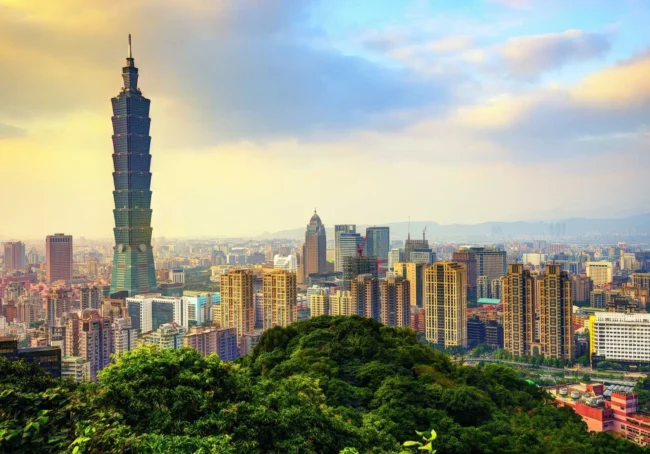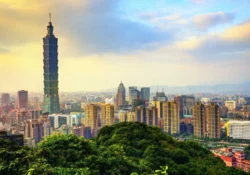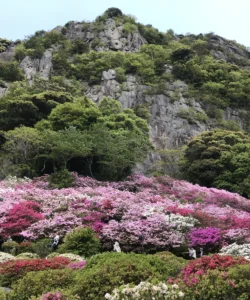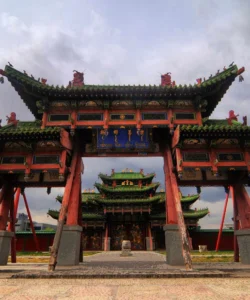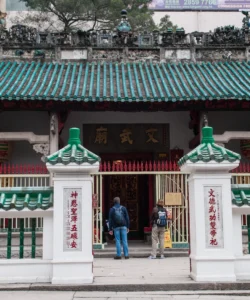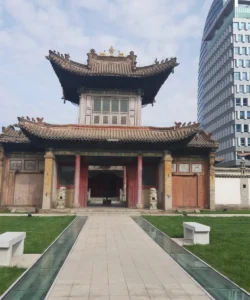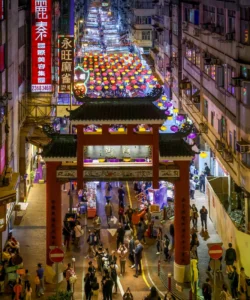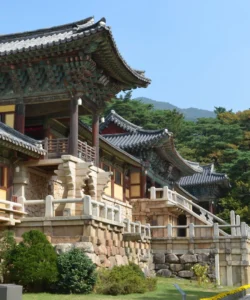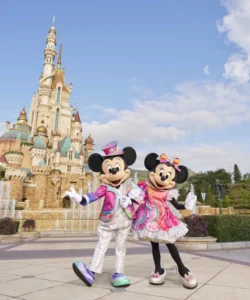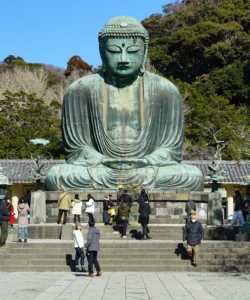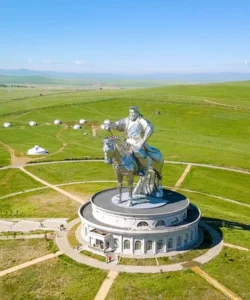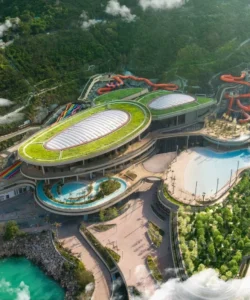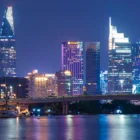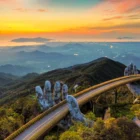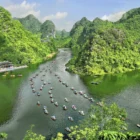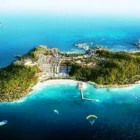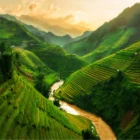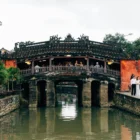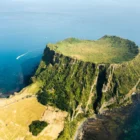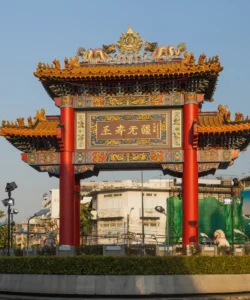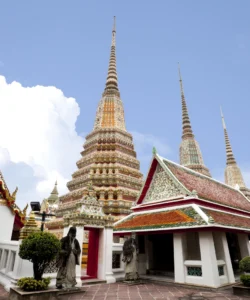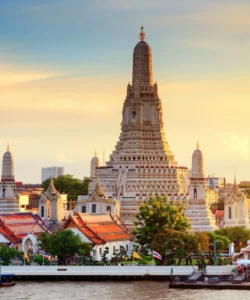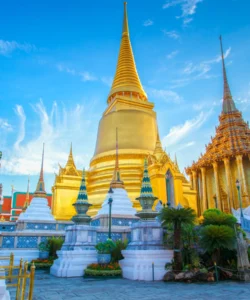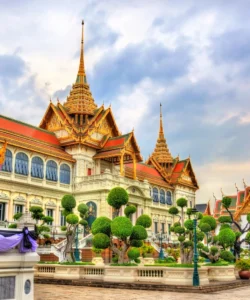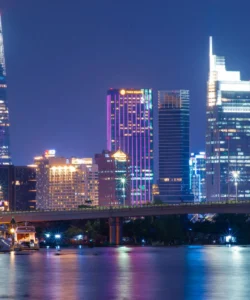Taipei 101 is an architectural marvel dominating the skyline of Taipei, Taiwan. Formerly known as the Taipei World Financial Center, it stood as the world’s tallest building from its completion in 2004 until the inauguration of the Burj Khalifa in Dubai in 2010. Beyond its impressive height, Taipei 101 is celebrated for its distinctive design, innovative engineering, and its status as a symbol of modern Taiwan’s prosperity and technological prowess.
Name: Taipei 101 (臺北101)
Address: No. 7, Section 5, Xinyi Road, Xinyi District, Taipei City, Taiwan 111. It is located in the heart of Taipei’s Xinyi District, a bustling financial and commercial hub.
How to get there:
Taipei 101 is extremely well-connected within Taipei’s efficient public transport network:
- By MRT (Mass Rapid Transit): This is the most convenient way. Take the Tamsui-Xinyi Line (Red Line) to Taipei 101/World Trade Center Station (Exit 4). This exit leads directly to the B1 (basement 1) level of Taipei 101.
- By Bus: Numerous city bus routes serve the Xinyi District, with many stops near Taipei 101 or the Taipei City Hall area.
- By Taxi/Ride-Sharing Services: Taxis are readily available throughout Taipei and can drop you off directly at the entrance.
- Walking: The tower is a central landmark in the Xinyi shopping district, making it easily walkable from many nearby attractions, hotels, and shopping malls. It’s also a popular starting point for the hike up Elephant Mountain for panoramic city views.
Landscape and Architecture:
Taipei 101’s architecture is a striking blend of modern engineering with traditional Asian aesthetics, standing as a beacon in its urban landscape:
- Bamboo-Inspired Design: The tower’s most recognizable feature is its unique design, resembling a towering stalk of bamboo with eight distinct sections. The number eight is considered auspicious in Chinese culture, symbolizing prosperity and good fortune. This design also evokes the shape of an elongated pagoda.
- Height and Floors: Standing at 508 meters (1,667 feet) with 101 floors above ground (and 5 basement floors), it was a record-breaker for its height.
- Sustainable Design (LEED Platinum): Taipei 101 is renowned as a pioneer in sustainable skyscraper design. It received LEED Platinum certification, the highest rating for green buildings. Its features include double Low-E glass (for heat and UV protection), an energy management control system, and a rainwater harvesting system, making it one of the tallest “green” buildings in the world.
- Tuned Mass Damper: A unique and visible engineering marvel, the 660-metric-ton steel pendulum (the world’s largest and heaviest tuned mass damper) is suspended between the 88th and 92nd floors. This giant golden sphere sways to offset oscillations in the building caused by strong winds (common during typhoons) and earthquakes, ensuring the skyscraper’s stability. It’s an attraction in itself, visible from the indoor observation deck.
- Super-Fast Elevators: The tower boasts some of the world’s fastest elevators, whisking visitors from the 5th floor to the 89th-floor indoor observatory in just 37 seconds, at speeds of up to 60 km/h (37 mph).
- Observation Decks: Public observation decks are located on the 89th floor (indoor, 360-degree views) and the 91st floor (outdoor, weather permitting), offering breathtaking panoramic views of Taipei City and beyond. The 101st floor also has a private, higher observatory.
- Retail and Dining: The lower floors (B1 to 4F) house a luxurious shopping mall with international brands, fine dining restaurants, and a bustling food court.
- New Year’s Eve Fireworks: Taipei 101 is internationally famous as the centerpiece of Taipei’s spectacular New Year’s Eve fireworks display, drawing massive crowds and global media attention.
What makes it famous:
Taipei 101 is famous for:
- Former World’s Tallest Building: Holding this prestigious title for six years (2004-2010) cemented its place in global architectural history.
- Iconic Symbol of Taiwan: Its distinctive appearance and prominence in the skyline make it the most recognizable symbol of Taiwan’s economic prosperity, technological advancement, and cultural identity.
- New Year’s Eve Fireworks: The annual dazzling fireworks display, launched directly from the tower, is a globally broadcast event.
- Engineering Marvel for Earthquakes and Typhoons: Its sophisticated design, particularly the massive tuned mass damper, allows it to withstand Taiwan’s frequent seismic activity and strong typhoon winds, showcasing cutting-edge engineering.
- World’s Tallest Green Building: Its commitment to sustainability and LEED Platinum certification made it a global leader in environmentally conscious skyscraper design.
- Fastest Elevators: Its record-breaking high-speed elevators are a thrilling part of the visitor experience.
- Panoramic City Views: The observation decks offer unparalleled 360-degree views of the sprawling Taipei metropolis.
Differences from some other wonders:
Taipei 101 stands out from other wonders, particularly other supertall skyscrapers or observation towers, in several distinct ways:
- Visible Tuned Mass Damper: While many modern supertalls have tuned mass dampers for stability, Taipei 101’s 660-ton pendulum is the world’s largest and, crucially, is visible to the public from its observation deck. This allows visitors to directly see and understand the engineering feat that keeps the building stable, a unique educational and visual experience.
- Auspicious Bamboo/Pagoda Design: Its architecture is deeply embedded with Chinese cultural symbolism, specifically the shape of a bamboo stalk and the auspicious number eight. This clear and intentional cultural inspiration in its external form is more pronounced than in many other skyscrapers, which might focus more on pure modernity or abstract aesthetics.
- Pioneer in Green Skyscraper Design: Taipei 101 was one of the first supertall skyscrapers globally to achieve LEED Platinum certification, setting a new benchmark for sustainable design in high-rise construction. This pioneering role in environmental responsibility distinguishes it from many earlier supertalls.
- Specific Earthquake and Typhoon Resistance: Due to Taiwan’s location in a high seismic and typhoon zone, Taipei 101’s design and construction had to specifically prioritize and innovate in extreme weather and seismic resilience to a degree arguably more critical than in many other supertall locations.
- The “Moment” of World’s Tallest: Its distinct period as the “world’s tallest building” before the Burj Khalifa’s completion gives it a specific historical significance in the timeline of global supertall architecture.
In essence, Taipei 101 is not just a towering structure; it is a harmonious blend of cultural aesthetics, groundbreaking engineering, and environmental stewardship, a vibrant symbol of Taiwan’s ingenuity and its confident stride into the future.
